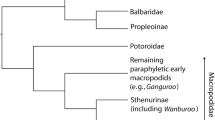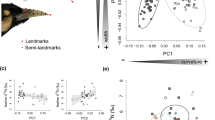Summary
There is disagreement as to the number of genera comprising the mannikins (Lonchurinae). Some authors recognize two to five of the following genera:Lonchura, Euodice, Padda, Spermestes andOdontospiza. Other authors have merged the last four taxa into the enlarged genusLonchura. We bring together data from downy plumes (neossoptiles), nestling palate markings, begging vocalizations, agonistic behaviour, courtship postures and starch gel electrophoresis of allozymes to solve these taxonomic problems. PAUP analysis of the combined data set indicates thatSpermestes andOdontospiza belong to a monophyletic clade separate fromEuodice, Padda andLonchura. We propose mergingOdontospiza withSpermestes, which suggests an African radiation of the group, and placing the generaPadda andEuodice in withLonchura, which represents a mostly Australasian radiation. The genusAmadina has been treated by some as a mannikin (Lonchurinae) and by others as a waxbill (Estrildinae). Our data indicate thatAmadina should be assigned to the estrildines rather than the lonchurines.Amadina's relatively large, mannikin-like conical bill is a result of convergence, probably reflecting selection pressure on bill shape associated with diet specializations.
Zusammenfassung
Die eigentliche Zahl an Gattungen innerhalb der Nonnen (Lonchurinae) ist umstritten. Einige Autoren erkennen zwei bis fünf von den folgenden Gruppen an:Lonchura, Euodice, Padda, Spermestes, undOdontospiza. Letztere vier Gruppen sind von anderen Autoren in eine vergrößerteLonchura-Gattung vereinigt worden. Um diese taxonomischen Probleme zu lösen, präsentieren wir Daten an neossoptilen Daunenfedern, Rachenzeichnungen, Bettellautäußerungen, agonistischen Verhaltensweisen, Balzverhalten und Stärkegel-Elektrophorese von Proteinen. Eine PAUP (phylogenetische) Analyse aller Daten ergibt folgendes:Spermestes undOdontospiza gehören einer monophyletischen Clade an. Gleiches gilt für die GattungenEuodice, Padda undLonchura. Demzufolge schlagen wir vor, daßOdontospiza der GattungSpermestes, undPadda undEuodice der GattungLonchura, zugeordnet werden sollen. Damit stellt sichSpermestes als eine afrikanische, undLonchura als eine hauptsächlich australasiatische Radiation vor. Die GattungAmadina wird von einigen Autoren den Nonnen (Lonchurinae), von anderen den Eigentlichen Prachtfinken (Estrildinae) zugeordnet. Unsere Daten zeigen, daßAmadina den Estrildiden und nicht den Lonchurinen angehört. Der große kegelförmige, nonnenähnliche Schnabel vonAmadina ist aufgrund nahrungsbedingtem Selektionsdruck wohl durch Konvergenz zustande gekommen.
Similar content being viewed by others
References
Aebersold, P.B., Winans, G.A., Teel, D.J., Milner, G.B. & Utter, F.M. (1987): Manual for starch gel electrophoresis: A method for detection of genetic variation. U. S. Dept. Commerce, National Oceanic and Atmospheric Admin., National Marine Fisheries Service.
Ayala, F.J., Powell, J.R., Tracy, M.L., Mourao, C.A. & Perez-Salas, S. (1972): Enzyme variability in theDrosophila willistoni group. IV. Genetics 70: 133–139.
Baptista, L.F. (1973): On courtship displays and the taxonomic position of the Grey-headed Silverbill. Avicult. Mag. 79: 149–154.
Baptista, L.F. & Atwood, A.L. (1980): Agonistic behaviour in the Java Finch. J. Ornithol. 122: 171–179.
Baptista, L.F. & Horblit, H.M. (1990): The inheritance and loss of the straw display in estrildid finches. Avicult. Mag. 96: 141–152.
Baptista, L.F. & Trail, P.W. (1988): On the origin of Darwin's finches. Auk 105: 663–671.
Bentz, G.D. (1979): The appendicular myology and phylogenetic relationships of the Ploceidae and Estrildidae (Aves: Passeriformes). Bull. Carnegie Mus. Nat. Hist. No. 15: 1–25.
Buth, D.G. (1984): The application of electrophoretic data in systematic studies. Ann. Rev. Ecol. Syst. 15: 501–522.
Christidis, L. (1986): Chromosomal evolution within the family Estrildidae (Aves) I. The Poephilae. Genetica 71: 81–97.
Christidis, L. (1987): Biochemical systematics within paleotropic finches (Aves: Estrildidae). Auk 104: 380–391.
Clayton, J.W. & Tretiak, D.N. (1972): Amine-citrate buffers for pH control in starch-gel electrophoresis. J. Fish. Res. Board Canada 29: 1169–1172.
Delacour, J. (1943): A revision of the subfamily Estrildinae of the family Ploceidae. Zoologica 28: 69–86.
De Queiroz, A. & Lawson, R. (1994): Phylogenetic relationships of the garter snakes based on DNA sequence and allozyme variation. Biol. J. Linn. Soc. 53: 209–229.
Eisner, E. (1958): Bengalese Finch x Silverbill hybrids. Avicult. Mag. 64: 51–54.
Fehrer, J. (1993): Interspezies-Kreuzungen bei cardueliden Finken und Prachtfinken. In: Scherer S. (ed.): Typen des Lebens. Berlin: 197–215.
Felsenstein, J. (1985): Confidence limits on phylogenies: an approach using the bootstrap. Evolution 39: 783–791.
Gahr, M., & Güttinger, H.-R. (1985): Korrelation zwischen der sexualdimorphen Gehirndifferenzierung und der Verhaltensausprägung bei Prachtfinken (Estrildidae). J. Ornithol. 126: 310.
Gahr, M., & Güttinger, H.-R. (1986): Functional aspects of singing in male and femaleUraeginthus bengalus (Estrildidae). Ethology 72: 123–131.
Glatthaar, R. & Ziswiler, V. (1971): Ontogenie und histologie der Rachenzeichnungen bei Prachtfinken, Estrildidae. Rev. suisse de Zoologie 78: 1222–1230.
Goodwin, D. (1982): Estrildid Finches of the World. British Museum (Nat. Hist.) London.
Grant, B.R. (1985): Selection on bill characters in a population of Darwin's finches:Geospiza conirostris on Isla Genovesa, Galapagos. Evolution 39: 523–532.
Güttinger, H.-R. (1970): Zur Evolution von Verhaltensweisen und Lautäußerungen bei Prachtfinken (Estrildidae). Z. Tierpsychol. 27: 1011–1075.
Güttinger, H.-R. (1976): Zur systematischen Stellung der GattungenAmadina, Lepidopygia undLonchura (Aves, Estrildidae). Bonn. Zool. Beitr. 27: 218–244.
Harris, H. & Hopkinson, D.A. (1976): Handbook of Enzyme Electrophoresis in Human Genetics. Amsterdam.
Harrison, C.J.O. (1962): A Silverbill × Bengalese Finch hybrid. Avicult. Mag. 68: 30–33.
Harrison, C.J.O. (1964): The taxonomic status of the African SilverbillLonchura cantans and the Indian SilverbillL. malabarica. Ibis 106: 462–468.
Hillis, D.M. & Bull, J.J. (1993): An empirical test of bootstrapping as a method for assessing confidence in phylogenetic analysis. Syst. Biol. 42: 182–192.
Immelmann, K. (1982): Australian Finches in Bush and Aviary. Sydney.
Immelmann, K., Steinbacher, J. & Wolters, J.E. (1977): Vögel in Käfig und Voliere, Prachtfinken. Vol. II, Aachen.
Kakizawa, R. & Watada, M. (1985): The evolutionary genetics of the Estrildidae. J. Yamashina Inst. Ornithol. 17: 143–158.
Mabee, P.M. & Humphries, J. (1993): Coding polymorphic data: Examples from allozymes and ontogeny. Syst. Biol. 42: 166–181.
Manchenko, G.P. (1994): Handbook of Detection of Enzymes on Electrophoretic Gels. Boca Raton, FL.
Marcus, M.B. (1970): A preliminary survey of the occurrence of neossoptiles in South African passeriform birds, with special reference to natal pteryloses. MS thesis, Univ. Pretoria.
Mayr, E. (1968): The sequence of genera in the Estrildidae (aves). Breviora Mus. Comp. Zool. Vol. 287, Cambridge, MA.
Mickevich, M. F. & Johnson, M. (1976): Congruence between morphological and allozyme data in evolutionary influence and character evolution. Syst. Zool. 25: 260–270.
Morris, D. (1958): The comparative ethology of grassfinches (Erythrurae) and mannikins (Amadinae). Proc. Zool. Soc. London 131: 389–439.
Murphy, R.W. (1993): The phylogenetic analysis of allozyme data: Invalidity of coding alleles by presence/absence and recommended procedures. Biochem. Syst. Ecol. 21: 25–38.
Nicolai, J. (1964): Der Brutparasitismus der Viduinae als ethologisches Problem. Prägungsphänomene als Faktoren der Rassen- und Artbildung. Zeit. f. Tierpsychol. 21: 129–204.
Payne, R. B. (1973): Behavior, mimetic songs and song dialects, and relationships of the Parasitic Indigobirds (VIDUA) of Africa. Ornithol. Monogr. 11: 1–333.
Pohl-Apel, G. & Sossinka, R. (1984): Hormonal determination of song capacity in females of the Zebra Finch: critical phase of treatment. Z. Tierpsychol. 64: 330–336.
Restall, R. (1996): Munias and Mannikins. Sussex.
Schluter, D. (1988): The evolution of finch communities on islands and continents: Kenya vs. Galápagos. Ecological Monographs 58: 229–249.
Selander, R.K., Smith, M.H., Yang, S.W., Johnson, W.E. & Gentry, J.B. (1971): Biochemical polymorphism and systematics in the genusPeromyscus. 1. Variation in the old-field mouse (Peromyscus polionotus). Studies in Genetics VI. Univ. Texas Publ. 7103:49–90.
Sibley, C.G. & Monroe, B.L. (1990): Distribution and Taxonomy of Birds of the World. New Haven, CT.
Smith, T.B. (1990): Resource use by bill morphs of an African finch: evidence for intraspecific competition. Ecology 71: 1246–1257.
Steiner, H. (1960): Klassifikation der Prachtfinken, Spermestidae, auf Grund der Rachenzeichnungen ihrer Nestlinge. J. Ornithol. 101: 421–447.
Swofford, D.L. (1993): PAUP: Phylogenetic analysis using parsimony, Version 3.1 Computer program distributed by the Illinois Natural History Survey, Champaign, IL.
Wenzel, J. W. (1992): Behavioral homology and phylogeny. Annu. Rev. Ecol. Syst. 23: 361–381.
ten Cate, C.J. (1986): Listening behaviour and song learning in Zebra Finches. Anim. Behav. 34: 1267–1269.
Witherbee, D.K. (1957): Natal plumages and downy pteryloses of passerine birds of North America. Bull. Am. Mus. Nat. Hist. 113: 343–436.
Wolters, H.E. (1987): Zur Stammesgeschichte der afrikanischen Prachtfinken. Trochilus 8: 37–76.
Author information
Authors and Affiliations
Corresponding author
Rights and permissions
About this article
Cite this article
Baptista, L.F., Lawson, R., Visser, E. et al. Relationships of some mannikins and waxbills in the estrildidae. J Ornithol 140, 179–192 (1999). https://doi.org/10.1007/BF01653597
Accepted:
Published:
Issue Date:
DOI: https://doi.org/10.1007/BF01653597




